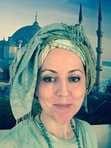What we don’t know about the Jinn
In our last article about the unseen we learned a little about what we know about the jinn. In this article I want to talk a little bit more about what we do not know. While I do want to use what is known as a jumping off point for the fantasy part of the novel, in short the Sulayman series is based upon what we do know on many topics but once the novel departs into fantasy there is speculation about what we do not know.
As the title indicates the story of Sulayman (as) will be significant to the ark of the character Sulayman (a contemporary character living in a time capsule world from the Golden Age of Islam) who is the hero in our story and we will learn more with him as he discovers more about this important encounter between the jinn world and the Prophetic History. One of the key things that we do not know when the novel starts is what happened to the jinn mother of the Queen of Sheba. Because of the significance of her daughter’s story we know some things about her but it is foggy at best.
We also do not know much about what happened to the father of Sheba. We do know that he broke the terms of his marriage contract and disappeared but other than that we are not sure. We do know that because the King of Sheba and his Queen and his son have disappeared that his daughter Bilqis became queen.
We know the jinn have tribes and culture of their own but we do not really know anything about how the jinn tribes relate to each other or in other words what their politics are. For the fantasy element of the novel I will explore this question a little more as well as the relationship between the believing and the unbelieving jinn. This point will be expanded upon in later books but in book one there will definitely be hints of the scale of what is to come.
One question the reader might ask themselves is what would be the politics of the believing versus the unbelieving jinn? What is the difference between their function and their appearance? What is the difference in the way that they interact with the human world based upon their state of belief. Without considering these questions the jinn might seem like a sort of monolithic unseen and all as more or less malevolent but this is not necessarily so, even according to what we do know about the jinn.
[image error]
Ibrahim (as) within the fire.
One of the richest bits I am wrestling with right now in the arc of the Sulayman series is how the jinn can live in water and be cold and wet at times if they are made of smokeless fire or what some speculate to be more or less electrical life forms. This is a very good question. Through my research it is clear that they are made of a kind of fire and there is indeed some confusion over their relationship with water. We know that water burns them but in some folklore the Marid jinn are said to live in the sea. When we think about sea monsters and mythical sea creatures in folklore it is so that they have many jinn like qualities and so this is an aspect of the jinn world that will take a little more thought. For now I will say that the story of the burning bush and the story of Ibrahim (as) feeling cool and at peace in the fire may be a clue about how beings that would otherwise be burnt either by fire or by water might hold a secret that allows them to do so.
[image error]
What I hope to achieve with the Sulayman series is a more clearly drawn picture of the jinn world than you find in the One Thousand and One Nights. In the Sulayman series the jinn world is a multi sensory and cultural experience, rather than a superficial and unsatisfying hint as you find in the Richard Francis Burton translation. Please share any research or stories you may know of about the jinn and if it suits the story arc you may find it in print.



